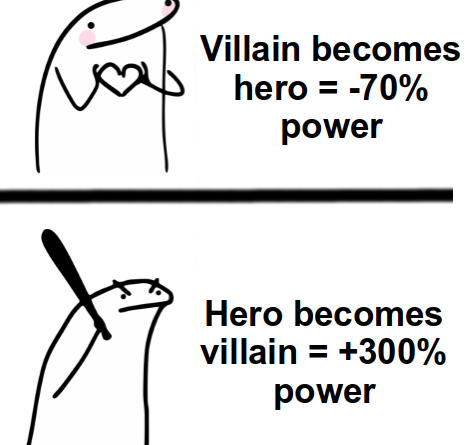… Hero-Villain-Hero-Villain … a sequence of divergent power!
A meme has been circulating on the internet these days showing:
- Villain becomes hero = -70% power
- Hero becomes villain = +300% power
So far so good, this is kind of true in the animated series… you see an overpowered guy going to the “good” side and starting to fight at the same level as the other heroes. Likewise, you see average characters going to the “evil” side and getting absurdly strong. (the meme is basically the same as the cover of this post, I just didn’t use the original images to avoid copyright issues)
But what caught my attention is that in the comments of this meme on the internet, there are several people saying that it would be enough for the hero who became a villain, to go back to being a hero who would continue with a high power. So, would this “method” work?
Let’s look at what happens for a random value (picking any value to test for relationships is always a good technique to understand what’s going on).
- Let’s assume the villain’s starting power is 900 (no matter what unit)
- When you become a hero, you lose 70% of this power, i.e. 900 – 9000.7 = 900 – 630 = 270 When you become a villain again, you increase this power by another 300%, that is, 270 + 2703 = 270 + 810 = 1080.
- Let’s assume the hero’s starting power is 270 (no matter what unit)
- When becoming a villain, increase this power by 300% more, i.e. 270 + 2703 = 270 + 810 = 1080
- When you become a hero again, you lose 70% of this power, that is, 1080 – 10800.7 = 1080 – 756 = 324.
In both cases our power increased after we went back from our initial choice. Let’s express this in general terms then, starting with the villain:
- Let’s assume the villain’s starting power is X
- When you become a hero, you lose 70% of this power, that is, X – X0.7 = X0.3
- When you become a villain again, you increase this power by 300%, that is, X0.3 + X0.33 = X0.3 + X0.9 = X1.2
Thus, with each return to his initial decision, the villain returns 20% stronger than he was initially. Let’s now analyze the hero:
- Let’s assume the hero’s starting power is Y
- When you become a villain, you increase this power by 300% more, that is, Y + Y3 = Y4
- When you become a hero again, you lose 70% of this power, that is, Y4 – Y40.7 = Y4 – Y2.8 = Y1.2
Thus, with each return to his initial decision, the hero returns 20% stronger than he was initially.
Cool, but mathematicians are lazy beings, so it would be very tiring to keep calculating this back and forth over and over again to know what the power would be after a character has changed sides N times. To resolve this issue, we can express the power of characters as terms of a sequence.
Let’s say that every character is born good and at some point he turned bad. So let the sequence be Power(N) where N represents how many times the character changed sides. So let’s take a look at this sequence to try to come up with a cute way to write it.
- Power(0) = X, where X > 0
- Power(1) = X4 Power(2) = X40.3
- Power(3) = X40.34
- Power(4) = X40.340.3
- Power(5) = X40.340.34
- Power(6) = X40.340.34*0.3
I think you can already see a certain pattern forming. See that if N is even, we will have that the 4 and 0.3 will be raised to the power of N/2, and if the N is odd, we will have that the 4 will be raised to the power of N/2 rounded up and the 0.3 will be raised to the power of N/2 rounded down.
So, to avoid these roundings, we will describe the sequence of evens, that is, for values of the form 2N and for odd ones, that is, for values of the form 2N + 1. In this way, given any Natural N, we can check in the sequence which will be the character’s power replacing N in one of the two expressions below.
- Power(2N) = X4^N(0.3)^N = X1.2^N
- Power(2N + 1) = X4^(N + 1)(0.3)^N = X41.2^N = 4Power(2N)
Anyway, to finish, let’s go to the question that everyone wants to know, if the character repeats this process infinite times, will he have infinite power? We can see that the power for 2N+1 will be given by 4 times the power for 2N, so to solve this question we can simply show that the limit for 2N tends to infinity, goes to infinity, which in turn the limit for 2N + 1 tending to infinity should also go.
- Lim [2N → ∞] X1.2^N =
- X*Lim [2N → ∞] 6^N/5^N
In this case, we see that 6^N will grow at a faster rate than 5^N. Thus, as N increases, 6^N/5^N will grow unrestrictedly. Examples:
- Power(0) = X
- Power(10) ~ X6.2
- Power(100) ~ X8.310⁷
- Power(1000) ~ X1.5*10⁷¹
We can see that this won’t stop growing 🙂

